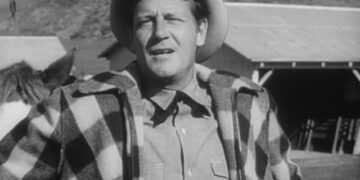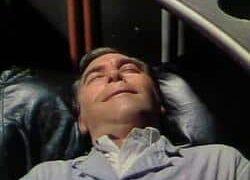Robert A. Heinlein, widely regarded as one of the greatest science fiction authors of all time, led a life as captivating and multifaceted as the worlds he created in his novels.
Born on July 7, 1907, in Butler, Missouri, Heinlein developed a passion for storytelling at a young age. His vivid imagination and keen intellect propelled him to become a prominent figure in the genre, leaving a lasting impact on both literature and popular culture.
Early life and upbringing
Heinlein’s upbringing played a significant role in shaping his future as a writer. Growing up in a family that valued education and free thinking, he was encouraged to explore his creative side.
However, his childhood wasn’t without its challenges. Heinlein’s family struggled financially, which taught him the value of hard work and perseverance in the face of adversity. These early experiences instilled in him a sense of resilience that would later permeate his writing.
Robert A. Heinlein’s writing career
Heinlein’s writing career began in the late 1930s, but it was his breakthrough novel, “Stranger in a Strange Land,” published in 1961, that catapulted him to literary stardom. Known for his thought-provoking ideas and exploration of themes such as individualism, libertarianism, and the nature of humanity, Heinlein’s works challenged the status quo and pushed the boundaries of the science fiction genre. His unique storytelling style and ability to blend social commentary with thrilling narratives captivated readers and earned him a dedicated fan base.
Criticism and controversy surrounding Robert A. Heinlein
No artist is immune to criticism, and Heinlein was no exception. Throughout his career, he faced both praise and backlash for his ideas and writing style. Some critics accused him of promoting militarism and espousing controversial political views.
Others criticized his treatment of female characters, claiming they were often one-dimensional or portrayed in a sexist manner. However, it is important to view Heinlein’s work within the context of the time in which it was written, acknowledging that societal norms and values have evolved since then.
Robert A. Heinlein’s personal life and relationships
Beyond his literary achievements, Heinlein’s personal life was equally intriguing. He married his wife, Leslyn, in 1932, but their relationship eventually ended in divorce. Heinlein’s second marriage to Virginia “Ginny” Gerstenfeld proved to be a lasting and loving partnership that lasted until his death in 1988. Their relationship was marked by mutual support and shared interests, with Ginny playing a crucial role in Heinlein’s career as his editor and confidante.
Exploring Robert A. Heinlein’s interests outside of writing
While writing consumed much of Heinlein’s life, he also pursued various interests beyond the realm of literature. He had a fascination with engineering and space exploration, which is evident in his novels that often incorporate scientific principles and futuristic technologies.
Furthermore, Heinlein was an advocate for individual freedoms and social progress, actively participating in political discussions and engaging with the world around him.
The impact and influence of Robert A. Heinlein’s work
Heinlein’s contributions to science fiction literature have had a profound impact on the genre and beyond. His novels continue to inspire new generations of writers and readers alike, challenging them to question societal norms and explore the possibilities of the human experience.
Heinlein’s visionary ideas have permeated popular culture, with references to his work appearing in movies, TV shows, and even scientific research. His influence can be felt in the works of authors such as Isaac Asimov, Arthur C. Clarke, and Philip K. Dick.
Notable quotes from Robert A. Heinlein
Heinlein’s writings are rich with insightful and thought-provoking quotes. One of his most famous quotes, “The most important lesson in the writing trade is that any manuscript is improved if you cut away the fat,” reflects his commitment to concise storytelling and the importance of editing.
Another notable quote, “A generation which ignores history has no past and no future,” demonstrates his belief in the significance of learning from the past to shape a better future.
A guide to Robert A. Heinlein’s best books
Heinlein’s extensive body of work can be overwhelming for those new to his writing. To help navigate his vast bibliography, here is a guide to some of his best books. “Stranger in a Strange Land” remains a classic and thought-provoking exploration of human nature and society. “Starship Troopers” delves into themes of duty, sacrifice, and the nature of war.
“The Moon Is a Harsh Mistress” presents a captivating tale of rebellion set on a lunar colony. These are just a few examples of Heinlein’s exceptional storytelling prowess.
The evolution of Robert A. Heinlein’s writing style
Throughout his career, Heinlein’s writing style evolved, reflecting the changing landscape of science fiction and his own personal growth. His early works, such as “Rocket Ship Galileo” and “The Puppet Masters,” showcased his talent for fast-paced action and thrilling adventures.
As he matured as a writer, Heinlein began incorporating more complex themes and philosophical ideas into his novels. This evolution allowed him to tackle social issues in a nuanced and thought-provoking manner.
Robert A. Heinlein’s books adapted into movies and other media
Heinlein’s imaginative worlds have not only captured the hearts of readers but have also made their way onto the silver screen. Several of his books have been adapted into movies and TV shows, bringing his stories to a wider audience.
“Starship Troopers,” directed by Paul Verhoeven, became a cult classic, while “The Puppet Masters” and “The Moon Is a Harsh Mistress” were also adapted into films. These adaptations have helped to introduce Heinlein’s work to new fans and further cement his status as a literary icon.
Other artists who inspired Robert A. Heinlein
Like any creative genius, Heinlein drew inspiration from a wide range of sources. Among the artists who influenced his work were H.G. Wells, whose imaginative storytelling sparked Heinlein’s own desire to create worlds of wonder.
Heinlein also admired the works of Rudyard Kipling, whose writings explored themes of adventure and colonialism. These and other influences shaped Heinlein’s unique voice and contributed to the richness of his storytelling.
Recommended readings by other authors influenced by Robert A. Heinlein
Heinlein’s impact on the world of science fiction is undeniable, and many authors have been inspired by his groundbreaking work. If you’re a fan of Heinlein and eager to explore other writers who share his visionary spirit, consider diving into the works of Isaac Asimov, whose “Foundation” series presents a sweeping vision of the future.
Arthur C. Clarke’s “2001: A Space Odyssey” is another must-read, as it combines stunning scientific concepts with thought-provoking philosophical themes.
Conclusion: Robert A. Heinlein’s lasting legacy
Robert A. Heinlein’s contributions to literature and science fiction continue to resonate with readers today. His captivating storytelling, bold ideas, and thought-provoking themes have solidified his place as a literary icon.
Whether you’re a long-time fan or new to his works, exploring Heinlein’s extraordinary life and unforgettable novels is sure to be a journey of discovery and inspiration.
If you’re ready to embark on an adventure through the worlds of Robert A. Heinlein, start with his seminal work “Stranger in a Strange Land” and let your imagination soar. Discover why Heinlein’s novels have stood the test of time and continue to captivate readers across the globe.
Fuel our passion by treating us to a coffee or enrich your collection with the captivating books of Robert A. Heinlein on Amazon through this link.
Join the WFTS revolution and champion the enduring allure of books with us! We’re committed to keeping your experience ad-free and authentically engaging.
Step into our world, where we value substance over flash, and keep the magic of books alive.










